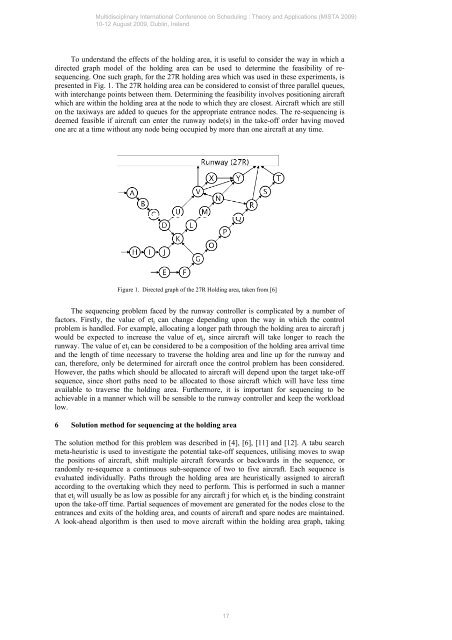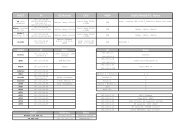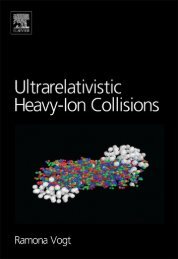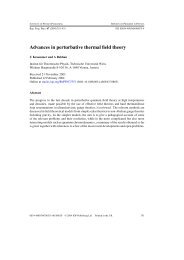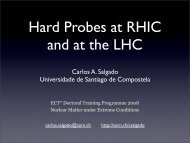- Page 1 and 2: MISTA 2009 Proceedings of the 4 th
- Page 3 and 4: Ribeiro, Celso Rudova, Hana Sagir,
- Page 5 and 6: Multidisciplinary International Con
- Page 7 and 8: Multidisciplinary International Con
- Page 9 and 10: Abstracts Multidisciplinary Interna
- Page 11 and 12: Multidisciplinary International Con
- Page 13 and 14: MISTA 2009 A comparison of two meth
- Page 15 and 16: Multidisciplinary International Con
- Page 17: Multidisciplinary International Con
- Page 21 and 22: Multidisciplinary International Con
- Page 23 and 24: Multidisciplinary International Con
- Page 25 and 26: Multidisciplinary International Con
- Page 27 and 28: stand hold. A less equitable take-o
- Page 29 and 30: MISTA 2009 ‘Strong’-‘Weak’
- Page 31 and 32: Multidisciplinary International Con
- Page 33 and 34: 4 7 S3 P1 Multidisciplinary Interna
- Page 35 and 36: Multidisciplinary International Con
- Page 37 and 38: Multidisciplinary International Con
- Page 39 and 40: We mention the following immediate
- Page 41 and 42: Multidisciplinary International Con
- Page 43 and 44: References Multidisciplinary Intern
- Page 45 and 46: Multidisciplinary International Con
- Page 47 and 48: Multidisciplinary International Con
- Page 49 and 50: Multidisciplinary International Con
- Page 51 and 52: Multidisciplinary International Con
- Page 53 and 54: Multidisciplinary International Con
- Page 55 and 56: Multidisciplinary International Con
- Page 57 and 58: use of TrainTRACS. Much stress is r
- Page 59 and 60: Multidisciplinary International Con
- Page 61 and 62: A schedule is a function t : N →
- Page 63 and 64: Multidisciplinary International Con
- Page 65 and 66: defining the vertex, bring an incon
- Page 67 and 68: Fig. 1 Multidisciplinary Internatio
- Page 69 and 70:
MISTA 2009 Polynomial algorithm for
- Page 71 and 72:
Multidisciplinary International Con
- Page 73 and 74:
Multidisciplinary International Con
- Page 75 and 76:
Here is an example of a group: Figu
- Page 77 and 78:
Finally, the algorithm for the prob
- Page 79 and 80:
Multidisciplinary International Con
- Page 81 and 82:
the constraints that is desirable f
- Page 83 and 84:
Multidisciplinary International Con
- Page 85 and 86:
References Multidisciplinary Intern
- Page 87 and 88:
Multidisciplinary International Con
- Page 89 and 90:
m
- Page 91 and 92:
Multidisciplinary International Con
- Page 93 and 94:
Multidisciplinary International Con
- Page 95 and 96:
Multidisciplinary International Con
- Page 97 and 98:
Multidisciplinary International Con
- Page 99 and 100:
Multidisciplinary International Con
- Page 101 and 102:
Multidisciplinary International Con
- Page 103 and 104:
comparison with GRASP-CST (3.289 se
- Page 105 and 106:
Multidisciplinary International Con
- Page 107 and 108:
machines and also the sequence of b
- Page 109 and 110:
3 Heuristic Approaches 3.1 ATC-BATC
- Page 111 and 112:
3. Create a sample of a [ 0, 1] U d
- Page 113 and 114:
Multidisciplinary International Con
- Page 115 and 116:
three metaheuristics the ACS approa
- Page 117 and 118:
Multidisciplinary International Con
- Page 119 and 120:
Multidisciplinary International Con
- Page 121 and 122:
3.1 Construction method to build in
- Page 123 and 124:
A bias is introduced in the perturb
- Page 125 and 126:
average normalized time 1 0.8 0.6 0
- Page 127 and 128:
Instance Avg. COEV Best COEV Avg. t
- Page 129 and 130:
References Multidisciplinary Intern
- Page 131 and 132:
MISTA 2009 Empowerment-based Workfo
- Page 133 and 134:
Problem formulation is a very impor
- Page 135 and 136:
Multidisciplinary International Con
- Page 137 and 138:
Multidisciplinary International Con
- Page 139 and 140:
5 Prototype For the model outlined
- Page 141 and 142:
Multidisciplinary International Con
- Page 143 and 144:
Multidisciplinary International Con
- Page 145 and 146:
Multidisciplinary International Con
- Page 147 and 148:
physicians requires satisfying a ve
- Page 149 and 150:
o Similarly, a physician cannot als
- Page 151 and 152:
U i lL Ail jJ kK lL Xijkl i I (1
- Page 153 and 154:
Multidisciplinary International Con
- Page 155 and 156:
Multidisciplinary International Con
- Page 157 and 158:
optimization models with meta-heuri
- Page 159 and 160:
Multidisciplinary International Con
- Page 161 and 162:
2.2 Problem formulation In order to
- Page 163 and 164:
Multidisciplinary International Con
- Page 165 and 166:
( 0 ≤1) ≤ HMCR . Other values t
- Page 167 and 168:
Multidisciplinary International Con
- Page 169 and 170:
Multidisciplinary International Con
- Page 171 and 172:
Step 1. Initialize parameters Step
- Page 173 and 174:
Multidisciplinary International Con
- Page 175 and 176:
Multidisciplinary International Con
- Page 177 and 178:
Multidisciplinary International Con
- Page 179 and 180:
References Multidisciplinary Intern
- Page 181 and 182:
MISTA 2009 A Guided Search Genetic
- Page 183 and 184:
Multidisciplinary International Con
- Page 185 and 186:
Multidisciplinary International Con
- Page 187 and 188:
Multidisciplinary International Con
- Page 189 and 190:
Multidisciplinary International Con
- Page 191 and 192:
In order to test the performance of
- Page 193 and 194:
MISTA 2009 Scheduling Semiconductor
- Page 195 and 196:
Considering the scale of integratio
- Page 197 and 198:
process. The processing time of all
- Page 199 and 200:
processing times regardless of the
- Page 201 and 202:
Multidisciplinary International Con
- Page 203 and 204:
MISTA 2009 Hybrid of the weighted m
- Page 205 and 206:
Multidisciplinary International Con
- Page 207 and 208:
e) Non-negativity constraint: δ ,
- Page 209 and 210:
Multidisciplinary International Con
- Page 211 and 212:
Multidisciplinary International Con
- Page 213 and 214:
Multidisciplinary International Con
- Page 215 and 216:
Figure 2L: Heuristics Comparison by
- Page 217 and 218:
MISTA 2009 An exact algorithm for t
- Page 219 and 220:
3 Lagrangian relaxation and dynamic
- Page 221 and 222:
3.4 Recovering the relaxed constrai
- Page 223 and 224:
4.2 Reduction by dominance theorem
- Page 225 and 226:
Stage 2 The multipliers are re-adju
- Page 227 and 228:
Multidisciplinary International Con
- Page 229 and 230:
Multidisciplinary International Con
- Page 231 and 232:
Multidisciplinary International Con
- Page 233 and 234:
to the Uj criterion) of any job se
- Page 235 and 236:
x + ki and x− ki since, if ytk =
- Page 237 and 238:
Multidisciplinary International Con
- Page 239 and 240:
Multidisciplinary International Con
- Page 241 and 242:
Multidisciplinary International Con
- Page 243 and 244:
Multidisciplinary International Con
- Page 245 and 246:
subject to: Multidisciplinary Inter
- Page 247 and 248:
function scheduleActivity schedule
- Page 249 and 250:
Multidisciplinary International Con
- Page 251 and 252:
#feasible[-] #feasible Fig. 5 Param
- Page 253 and 254:
A List of Variables Multidisciplina
- Page 255 and 256:
MISTA 2009 Decomposed Software Pipe
- Page 257 and 258:
Multidisciplinary International Con
- Page 259 and 260:
Multidisciplinary International Con
- Page 261 and 262:
pattern is λ R = 9 and it gives th
- Page 263 and 264:
vr: the number of non-idle cycles o
- Page 265 and 266:
Let h =< Tj1 , · · · , Tjc , Sto
- Page 267 and 268:
MISTA 2009 Scheduling policy for on
- Page 269 and 270:
Multidisciplinary International Con
- Page 271 and 272:
Multidisciplinary International Con
- Page 273 and 274:
Multidisciplinary International Con
- Page 275 and 276:
Multidisciplinary International Con
- Page 277 and 278:
References Multidisciplinary Intern
- Page 279 and 280:
Fig. 1 Sweep Width [18] Multidiscip
- Page 281 and 282:
Destress Call Or Intelligence Fig.
- Page 283 and 284:
asearchefforts relocation heuristic
- Page 285 and 286:
Fig. 7 Flight Plan γ 1 2 τ (t 2 )
- Page 287 and 288:
Multidisciplinary International Con
- Page 289 and 290:
5 Computational Study Multidiscipli
- Page 291 and 292:
Multidisciplinary International Con
- Page 293 and 294:
Multidisciplinary International Con
- Page 295 and 296:
A new schedule Ψ’ could be gener
- Page 297 and 298:
Multidisciplinary International Con
- Page 299 and 300:
Orders 1, 2, ..., k − 1 Order k O
- Page 301 and 302:
An Illustrative Example: We conside
- Page 303 and 304:
need for methodology that allows fi
- Page 305 and 306:
Multidisciplinary International Con
- Page 307 and 308:
Theorem 1 DVP1 is NP-complete even
- Page 309 and 310:
Step 2. Calculate the minimum amoun
- Page 311 and 312:
14. Slotnick, S.A. and Sobel, M.J.,
- Page 313 and 314:
Multidisciplinary International Con
- Page 315 and 316:
Pr: the cancellation cost for non-p
- Page 317 and 318:
Multidisciplinary International Con
- Page 319 and 320:
Multidisciplinary International Con
- Page 321 and 322:
the list considering, if necessary,
- Page 323 and 324:
load processing was proposed first
- Page 325 and 326:
(8). By constraints (9) schedule le
- Page 327 and 328:
3.3 Appender heuristics Multidiscip
- Page 329 and 330:
1E+2 1E+1 distance from LoBo BR1 BR
- Page 331 and 332:
MISTA 2009 Three Heuristic Procedur
- Page 333 and 334:
Multidisciplinary International Con
- Page 335 and 336:
Φ denote the density function and
- Page 337 and 338:
To illustrate the type of data we c
- Page 339 and 340:
the estimated standard deviation of
- Page 341 and 342:
Multidisciplinary International Con
- Page 343 and 344:
Multidisciplinary International Con
- Page 345 and 346:
The system energy loss curve repres
- Page 347 and 348:
T I ⎛ 0. 746γ ⎞ ⎡Qt , iH Min
- Page 349 and 350:
Multidisciplinary International Con
- Page 351 and 352:
Multidisciplinary International Con
- Page 353 and 354:
Multidisciplinary International Con
- Page 355 and 356:
X2 0 10 20 30 40 50 60 X1 Objective
- Page 357 and 358:
Multidisciplinary International Con
- Page 359 and 360:
problem involving the minimization
- Page 361 and 362:
Consider the following graph which
- Page 363 and 364:
2 2 2 2 2 For setξ 2 : p =3, p =6,
- Page 365 and 366:
( 1 2 2 2 ( ) 2 O n2 ) P n n O whil
- Page 367 and 368:
MISTA 2009 An efficient implicit en
- Page 369 and 370:
Multidisciplinary International Con
- Page 371 and 372:
Multidisciplinary International Con
- Page 373 and 374:
Multidisciplinary International Con
- Page 375 and 376:
Multidisciplinary International Con
- Page 377 and 378:
Multidisciplinary International Con
- Page 379 and 380:
MISTA 2009 Isomorphic coupled-task
- Page 381 and 382:
the objective is to find a feasible
- Page 383 and 384:
a1 A1 A2 A3 A4 A7 A5 A6 (a) An inpu
- Page 385 and 386:
Multidisciplinary International Con
- Page 387 and 388:
graphs: since the values of of a an
- Page 389 and 390:
the Minimum DISJOINT PATH COVER pro
- Page 391 and 392:
the currently omitted jobs are to b
- Page 393 and 394:
Multidisciplinary International Con
- Page 395 and 396:
Multidisciplinary International Con
- Page 397 and 398:
Multidisciplinary International Con
- Page 399 and 400:
If all incoming jobs can be perfect
- Page 401 and 402:
Multidisciplinary International Con
- Page 403 and 404:
3 ETP-HBMO Multidisciplinary Intern
- Page 405 and 406:
Multidisciplinary International Con
- Page 407 and 408:
Data sets Carter et al. [24] Di Gas
- Page 409 and 410:
Multidisciplinary International Con
- Page 411 and 412:
such as scheduling, data mining, cu
- Page 413 and 414:
placed in a restricted candidate li
- Page 415 and 416:
Multidisciplinary International Con
- Page 417 and 418:
and it was found that using a RCL w
- Page 419 and 420:
3.2.2 GRASP improvement phase The G
- Page 421 and 422:
Multidisciplinary International Con
- Page 423 and 424:
which can be adapted to construct g
- Page 425 and 426:
MISTA 2009 Multidisciplinary Intern
- Page 427 and 428:
obtained. Finally the paper is conc
- Page 429 and 430:
Multidisciplinary International Con
- Page 431 and 432:
Multidisciplinary International Con
- Page 433 and 434:
instances (that is, using a differe
- Page 435 and 436:
Multidisciplinary International Con
- Page 437 and 438:
Multidisciplinary International Con
- Page 439 and 440:
At each iteration, the exams are sc
- Page 441 and 442:
stable sets in G(V, E). A maximal c
- Page 443 and 444:
Multidisciplinary International Con
- Page 445 and 446:
Table 7. Best results from our IP b
- Page 447 and 448:
Multidisciplinary International Con
- Page 449 and 450:
Multidisciplinary International Con
- Page 451 and 452:
Multidisciplinary International Con
- Page 453 and 454:
The fitness of an individual is a f
- Page 455 and 456:
Multidisciplinary International Con
- Page 457 and 458:
7 Conclusion and Future Work The st
- Page 459 and 460:
MISTA 2009 Parallel Machine Problem
- Page 461 and 462:
Multidisciplinary International Con
- Page 463 and 464:
5. k[a, b] is defined as the set of
- Page 465 and 466:
Multidisciplinary International Con
- Page 467 and 468:
n v(Jk, Mq, Jj, ri) ≤ C(Jj, ri)
- Page 469 and 470:
Multidisciplinary International Con
- Page 471 and 472:
Multidisciplinary International Con
- Page 473 and 474:
Multidisciplinary International Con
- Page 475 and 476:
Multidisciplinary International Con
- Page 477 and 478:
Multidisciplinary International Con
- Page 479 and 480:
Multidisciplinary International Con
- Page 481 and 482:
Multidisciplinary International Con
- Page 483 and 484:
pij: processing time of job Ji on m
- Page 485 and 486:
4.1 The main procedure The proposed
- Page 487 and 488:
Multidisciplinary International Con
- Page 489 and 490:
4.2 Perturbation of Xk Multidiscipl
- Page 491 and 492:
the output with less computational
- Page 493 and 494:
Multidisciplinary International Con
- Page 495 and 496:
4049 129451 05 3964 122477 05 3842
- Page 497 and 498:
Multidisciplinary International Con
- Page 499 and 500:
Multidisciplinary International Con
- Page 501 and 502:
- - - - - - 2415 32509 05 2479 3364
- Page 503 and 504:
6471 391700 04 6434 395376 03 6509
- Page 505 and 506:
6871 381966 04 6572 393817 04 6830
- Page 507 and 508:
Multidisciplinary International Con
- Page 509 and 510:
Multidisciplinary International Con
- Page 511 and 512:
Multidisciplinary International Con
- Page 513 and 514:
Multidisciplinary International Con
- Page 515 and 516:
Multidisciplinary International Con
- Page 517 and 518:
t A B In summary, after repairing t
- Page 519 and 520:
MISTA 2009 Preemptive scheduling wi
- Page 521 and 522:
Multidisciplinary International Con
- Page 523 and 524:
[Preemptive scheduling problem SS12
- Page 525 and 526:
Multidisciplinary International Con
- Page 527 and 528:
Multidisciplinary International Con
- Page 529 and 530:
Multidisciplinary International Con
- Page 531 and 532:
it is possible to further reduce th
- Page 533 and 534:
paper, hence, is of importance in t
- Page 535 and 536:
Multidisciplinary International Con
- Page 537 and 538:
Multidisciplinary International Con
- Page 539 and 540:
Multidisciplinary International Con
- Page 541 and 542:
Multidisciplinary International Con
- Page 543 and 544:
Multidisciplinary International Con
- Page 545 and 546:
Multidisciplinary International Con
- Page 547 and 548:
6.2 Empirical Results Multidiscipli
- Page 549 and 550:
Multidisciplinary International Con
- Page 551 and 552:
8 Conclusions This paper analyzed t
- Page 553 and 554:
Multidisciplinary International Con
- Page 555 and 556:
Multidisciplinary International Con
- Page 557 and 558:
Multidisciplinary International Con
- Page 559 and 560:
Multidisciplinary International Con
- Page 561 and 562:
Multidisciplinary International Con
- Page 563 and 564:
Multidisciplinary International Con
- Page 565 and 566:
Multidisciplinary International Con
- Page 567 and 568:
Multidisciplinary International Con
- Page 569 and 570:
Unfortunately, List scheduling in d
- Page 571 and 572:
MISTA 2009 A deterministic resource
- Page 573 and 574:
are linear and integer programming
- Page 575 and 576:
yi(t): be the number of infected in
- Page 577 and 578:
where Ai, Bi, Γi are constants dep
- Page 579 and 580:
5. Illustrative example Multidiscip
- Page 581 and 582:
2. N. Altay, W.G. Green III. OR/MS
- Page 583 and 584:
change in the processing conditions
- Page 585 and 586:
3 Special case : no release dates T
- Page 587 and 588:
n K \m 10 20 30 50 100 Total K=2 60
- Page 589 and 590:
Proposition 3 Let us consider a seq
- Page 591 and 592:
In this formulation, constraints (1
- Page 593 and 594:
n k \m 10 20 30 40 k=2 0.0 0.7 18.7
- Page 595 and 596:
MISTA 2009 Tabu Search Techniques f
- Page 597 and 598:
Multidisciplinary International Con
- Page 599 and 600:
Multidisciplinary International Con
- Page 601 and 602:
Rule Condition Description of tabu
- Page 603 and 604:
Multidisciplinary International Con
- Page 605 and 606:
The experimental analysis shows tha
- Page 607 and 608:
MISTA 2009 A Water Flow Algorithm f
- Page 609 and 610:
Multidisciplinary International Con
- Page 611 and 612:
difference between the objective fu
- Page 613 and 614:
order of J1 to J5. J4 can usually b
- Page 615 and 616:
Multidisciplinary International Con
- Page 617 and 618:
MISTA 2009 Metaheuristic Approach t
- Page 619 and 620:
Multidisciplinary International Con
- Page 621 and 622:
generation, and the maximal standar
- Page 623 and 624:
Multidisciplinary International Con
- Page 625 and 626:
Multidisciplinary International Con
- Page 627 and 628:
evaluation of solutions and improve
- Page 629 and 630:
MISTA 2009 Generating Cyclic Fair S
- Page 631 and 632:
Multidisciplinary International Con
- Page 633 and 634:
Thus, the second aggregation combin
- Page 635 and 636:
The key distinctions between the hi
- Page 637 and 638:
i. Set i = S(s, a). Set L i equal t
- Page 639 and 640:
Multidisciplinary International Con
- Page 641 and 642:
Multidisciplinary International Con
- Page 643 and 644:
Multidisciplinary International Con
- Page 645 and 646:
Multidisciplinary International Con
- Page 647 and 648:
Multidisciplinary International Con
- Page 649 and 650:
Lemma 1 There exists an optimal sch
- Page 651 and 652:
Multidisciplinary International Con
- Page 653 and 654:
Multidisciplinary International Con
- Page 655 and 656:
5 Conclusions In this paper we have
- Page 657 and 658:
Multidisciplinary International Con
- Page 659 and 660:
Multidisciplinary International Con
- Page 661 and 662:
where Multidisciplinary Internation
- Page 663 and 664:
Multidisciplinary International Con
- Page 665 and 666:
Multidisciplinary International Con
- Page 667 and 668:
Multidisciplinary International Con
- Page 669 and 670:
Table 4 Computational results for S
- Page 671 and 672:
Multidisciplinary International Con
- Page 673 and 674:
jobs 0 → j → n+1, j = 1, . . .
- Page 675 and 676:
Fig. 1 Two schedules: one with pree
- Page 677 and 678:
Multidisciplinary International Con
- Page 679 and 680:
Fig. 7 Transformation of K5,2 Proof
- Page 681 and 682:
Multidisciplinary International Con
- Page 683 and 684:
Multidisciplinary International Con
- Page 685 and 686:
six neighbourhoods for the nurse ro
- Page 687 and 688:
the heuristic set is composed of as
- Page 689 and 690:
Psychiatry Normal Average Std. Dev.
- Page 691 and 692:
MISTA 2009 Reactive Nurse Schedulin
- Page 693 and 694:
personnel scheduling process and da
- Page 695 and 696:
during a working day in case of ext
- Page 697 and 698:
MISTA 2009 Multidisciplinary Intern
- Page 699 and 700:
Multidisciplinary International Con
- Page 701 and 702:
2 Problem formulation The analyzed
- Page 703 and 704:
MISTA 2009 Scatter search for a wei
- Page 705 and 706:
Multidisciplinary International Con
- Page 707 and 708:
MISTA 2009 A VNS-based solution app
- Page 709 and 710:
Table 1 Comparison of different sol
- Page 711 and 712:
3 Problem Definition The Malaysian
- Page 713 and 714:
∑xqt (1-αnq) + ∑xq(t+1) (1-αn
- Page 715 and 716:
5 Conclusion and future work The de
- Page 717 and 718:
Multidisciplinary International Con
- Page 719 and 720:
MISTA 2009 Round-robin Sports Sched
- Page 721 and 722:
MISTA 2009 Workforce Planning and S
- Page 723 and 724:
Multidisciplinary International Con
- Page 725 and 726:
MISTA 2009 Integrated workforce sta
- Page 727 and 728:
Multidisciplinary International Con
- Page 729 and 730:
Multidisciplinary International Con
- Page 731 and 732:
our method produces the best known
- Page 733 and 734:
MISTA 2009 Interactive Course Timet
- Page 735 and 736:
Multidisciplinary International Con
- Page 737 and 738:
References Multidisciplinary Intern
- Page 739 and 740:
Multidisciplinary International Con
- Page 741 and 742:
Multidisciplinary International Con
- Page 743 and 744:
plications of the block planning ap
- Page 745 and 746:
¡
- Page 747 and 748:
Multidisciplinary International Con
- Page 749 and 750:
MISTA 2009 Approximation algorithm
- Page 751 and 752:
3 Approximation algorithm for molda
- Page 753 and 754:
MISTA 2009 Solving a dock assignmen
- Page 755 and 756:
3 Three-stage flexible flow-shop In
- Page 757 and 758:
MISTA 2009 Project scheduling with
- Page 759 and 760:
3 Markov decision chain For Markovi
- Page 761 and 762:
proportion of precedence-related ac
- Page 763 and 764:
Multidisciplinary International Con
- Page 765 and 766:
MISTA 2009 On the Effective Approac
- Page 767 and 768:
2 Manifest Variables Production Mix
- Page 769 and 770:
MISTA 2009 Planning Heuristics for
- Page 771 and 772:
the lower bound for each P de. Let
- Page 773 and 774:
MISTA 2009 Order acceptance and sch
- Page 775 and 776:
Morton [7]. The first B&B algorithm
- Page 777 and 778:
Multidisciplinary International Con
- Page 779 and 780:
MISTA 2009 Real World Optimisation
- Page 781 and 782:
many alternative plans before going
- Page 783 and 784:
MISTA 2009 Scheduling in a micro-bi
- Page 785 and 786:
MISTA 2009 A self-organising hyper-
- Page 787 and 788:
simple structure and effectiveness.
- Page 789 and 790:
MISTA 2009 Multilevel search for ch
- Page 791 and 792:
MISTA 2009 HyFlex: A Flexible Frame
- Page 793 and 794:
Multidisciplinary International Con
- Page 795 and 796:
Instance number Size 0-9 20 × 5 10
- Page 797 and 798:
it will be conducted in a high-leve
- Page 799 and 800:
MISTA 2009 Multilevel Search for Ev
- Page 801 and 802:
Terminals Functions Delta (change i
- Page 803 and 804:
MISTA 2009 Scheduling of job shop,
- Page 805 and 806:
Multidisciplinary International Con
- Page 807 and 808:
formulations are considered superio
- Page 809 and 810:
MISTA 2009 Multidisciplinary Intern
- Page 811 and 812:
and independence of the residuals a
- Page 813 and 814:
esource levelling means to schedule
- Page 815 and 816:
Multidisciplinary International Con
- Page 817 and 818:
Multidisciplinary International Con
- Page 819 and 820:
3.3 Branch and Bound Multidisciplin
- Page 821 and 822:
Due to its inferior performance on
- Page 823 and 824:
increasingly easier to change the p
- Page 825 and 826:
Multidisciplinary International Con
- Page 827 and 828:
Update pheromone value τ ij counte
- Page 829 and 830:
Multidisciplinary International Con
- Page 831 and 832:
In this paper, we present a new evo
- Page 833 and 834:
Multidisciplinary International Con
- Page 835 and 836:
MISTA 2009 Variable Neighborhood De
- Page 837 and 838:
3 Computational results We evaluate
- Page 839 and 840:
how much fuel to take on at any giv
- Page 841 and 842:
Note that the activations of τi do
- Page 843 and 844:
and a best-case deadline BDi equal
- Page 845 and 846:
Multidisciplinary International Con
- Page 847 and 848:
Multidisciplinary International Con
- Page 849 and 850:
functionftransformsatimeunitalready
- Page 851 and 852:
Multidisciplinary International Con
- Page 853 and 854:
MISTA 2009 Speeding up the optimal
- Page 855 and 856:
Table 1 Speedup of the modified OPT
- Page 857 and 858:
Multidisciplinary International Con
- Page 859 and 860:
Multidisciplinary International Con


